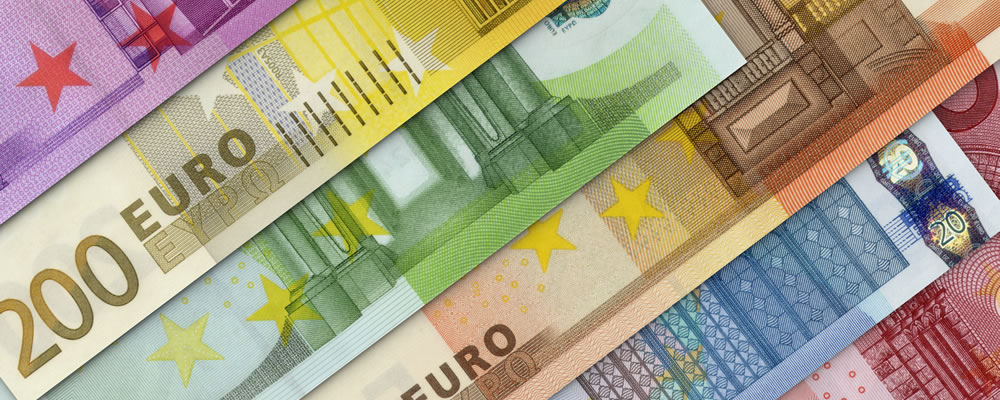Even though markets anticipate the European Central Bank (ECB) opting to extend its quantitative easing program, Euro (EUR) exchange rates have remained on a generally positive footing.
- Hopes of a rescue plan for the Italian banking sector support EUR – Drag from political uncertainty more limited
- Rising UK house prices shored up Pound Sterling – Investor confidence in domestic economy boosted
- US Dollar (USD) trended lower despite Fed rate hike odds – Upside potential of ‘Greenback’ muted
- ECB dovishness dented Euro exchange rates – Draghi talked down prospect of tapering despite robust Eurozone economy
Bullish UK data has helped to shore up the Pound, despite ongoing Brexit anxiety, while the US Dollar has struggled to return to an uptrend.
Dovish ECB Announcement Prompted EUR Exchange Rate Slump
The European Central Bank’s (ECB) December policy meeting provoked some significant volatility for EUR exchange rates on Thursday. Initially investors were encouraged by the fact that the value of the ECB’s monthly asset purchases had been lowered from 80 billion to 60 billion, which many interpreted as a sign of tapering. However, as the quantitative easing program was also extended by nine months and ECB President Mario Draghi took a decidedly dovish tone at the accompanying press conference this impression was soon reversed.
As a result the EUR GBP exchange rate was trending lower in the region of 0.84 towards the close of the European session, while the EUR USD pairing was slumped at 1.06.
(Previously updated at 11:17 on 08/12/16)
Euro (EUR) Exchange Rate Volatility Forecast on ECB Commentary
Despite October’s disappointing German industrial production figures, the appeal of the Euro (EUR) was quick to pick back up. Investors have remained generally optimistic over the chances of Monte dei Paschi being kept afloat by intervention from either the Italian government or the European Stability Mechanism (ESM). With fears of an imminent collapse receding EUR exchange rates were boosted, despite the persistent uncertainty that surrounds Italy’s future at this juncture.
Markets are widely expecting the European Central Bank (ECB) to extend its quantitative easing program at its final policy meeting of the year, a prospect which could weigh on the single currency. Even so, investors will be keen to hear the tone taken by ECB President Mario Draghi and the level of dovishness evidenced by the central bank. Also of interest will be any commentary relating to the Italian banking sector, with signs of a more supportive mentality likely to offer further support to the Euro.
Solid UK Housing Data Weighed on EUR GBP Exchange Rate
Overnight the RICS house price balance for November showed a stronger-than-expected uptick, rising 30% rather than the forecast 26%. This pointed towards continued robustness within the UK housing market, promoting confidence in the outlook of the wider economy. As a result the Euro Pound (EUR GBP) exchange rate trended higher on Thursday morning, despite ongoing market unease over the issue of Brexit.
Confidence in the Pound could be shored up more substantially if Friday’s trade data proves similarly encouraging. Forecasts are for the visible trade deficit to have narrowed from -12.6 billion to -11.8 billion in October, a solid improvement which would reinforce market optimism. However, given the rather fragile nature of the UK’s trade conditions at present any downside surprise could return Sterling to a sharp downtrend ahead of the weekend. Any widening in the deficit would not bode well for the economy’s ability to withstand further Brexit-based bearishness or negative political developments.
US Dollar to Pound (USD GBP), Euro (USD EUR) Upside Potential Limited Due to Market Fed Rate Hike Pricing
Demand for the US Dollar (USD) faltered on the back of disappointing October consumer credit data, which suggested that consumer confidence was not as resilient as might be hoped. While this somewhat undermined the positive market impression of the world’s largest economy, the odds remained high for an imminent Federal Reserve interest rate hike.
The Euro US Dollar (EUR USD) exchange rate climbed to a three-week high of 1.08 in response, despite the underlying strength of the ‘Greenback’. As Richard Fanulovich, research analyst at Westpac, noted:
‘Positioning suggests the USD is well owned, a Dec Fed hike is fully priced, our US surprise index suggests all the good news is priced in too and we are in a fiscal policy news vacuum likely until Trump’s 20 Jan inauguration. USD index could ease 1-2% before the next leg up.’
Some gains for the US Dollar could come on the back of December’s University of Michigan Confidence Index, assuming that sentiment is confirmed to have strengthened further. Nevertheless, if the measure falls short of expectations then the EUR USD exchange rate could push higher in the near term.
Current Interbank Exchange Rates
At the time of writing, the Euro Pound (EUR GBP) exchange rate was trending narrowly at 0.85, while the Euro US Dollar (EUR USD) pairing was making gains in the region of 1.07.



